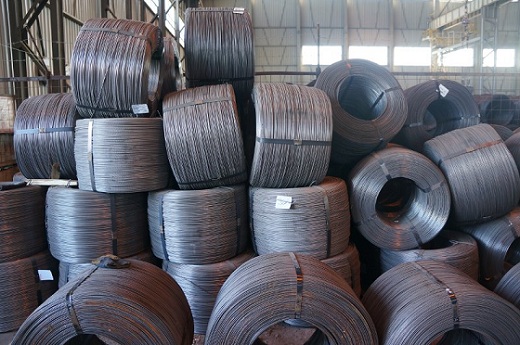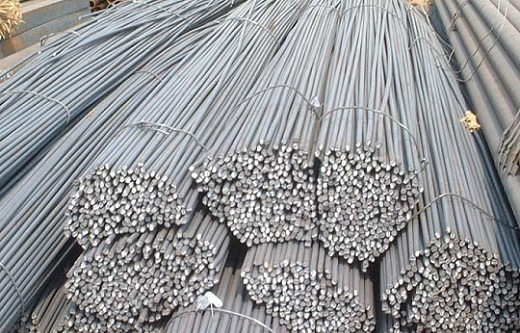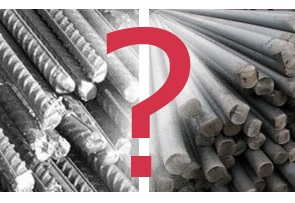Armature A1 in the international classification has a more modern designation - A240. Rental is made by hot-rolled method, and packaging and warehousing can be produced in traffic and rods. Be sure to comply with all the requirements of GOST 5781-82, which is responsible for this reinforcement.
Armature A1 is released solely smooth. Deviations of profile diameter, as well as geometry rolled rods are spelled out in GOST 2590-2006. In addition, the length of the rod is allowed to issue measuring and non-mechanics.
1 Main technical specifications
Class A1 fittings are smooth rods having a round cross-section, and which are not applied to any strokes or protrusions. On the axis of the rod, longitudinal ribs are often applied, improving the interaction and coupling with concrete.
Specifications suggest the manufacture mainly from carbon steel (ST 3PS / SP), less often from low-alloyed (special elements are added as chromium, manganese). Considering the chemical composition, you can observe a significant difference A240 from reinforcement A400 - A240 is allowed to be used in aggressive media, for example, in contact with chlorine or natural gas.
Such fittings can be thermally hardened (the labeling of the letter T) and the hardened extract (marking c) is read more about marking classes of fittings can be read separately. The weight of the product and its dimensions are directly proportional to the diameter of the rod.
Regarding diameter, it can be from 6 mm to 40 mm. The final length of the rod varies from 6 meters to 12. The type of supplies of the reinforcement directly depends on the diameter of the rod. Products up to 10 mm are folded into the machines and are supplied by bays. The diameter exceeding 10 mm means that such reinforcement will be packed with rods.

The presence of a certain number of numerical lengths in the batch is allowed. In each batch, their volume should not exceed 15% of the total weight of the party, and the rods themselves should not be shorter than 2500 mm.
By agreement it is possible to supply 100% of the rods of exceptionally measuring length. The reinforcement rods of the A1 class A1 do not have to be greater than a maximum of 12 meters. Moting weight is usually determined by the arrangement of the manufacturer with the customer. But in most cases it does not exceed 1.3 tons. This allows the use of bays in limited spaces, with the possibility of raising the crane-beam of low loading capacity.
1.1 On the use of reinforcement A1(video)
1.2 Scope of Armature A1
The largest distribution of the A240 fittings received production of looped elementswhich serve for fastening and hitch of reinforced concrete structures with each other. Also, loop fittings can be applied as a blockage for the main package of fittings, for example, A400. The main package in this case performs reinforcing functions, and the A240 reinforcement binds the A400 rods with each other.
1.3 Table of Sortiment
The table below takes into account the most common diameters of the A1 reinforcement. However, the table contains only theoretical calculations based on reference values. When calculating the actual weight, you need to take into account the status and settings of the rolling mill.
The table admits the deviation of the actual weight according to GOST and TU from the theoretical by 3-9%. These data are valid only for products supplied in rods.
2 nuances of using fittings A1
Armature A240, like any metal rolled, is supplied by parties. The maximum weight of one batch is up to 70 tons. This corresponds to the norm of loading the standard railway car. For each batch of products, a quality certificate must be issued according to GOST 7566-94, confirming the proper level of quality of the released products.
Packaging occurs packs, the weight of one on average varies from 4.5 to 8 tons. Every bundle it is necessary to tie in three places. To implement this, a steel tape is used, you can also use a packaging rod. To ensure mechanized loading and unloading packs using crane mechanisms, two clamps that serve to secure the sling are fixed on the ligaments.
At both ends, the pack must be attached tags on which there is information about the manufacturer, description of the type and size of the profile, the name of the rental, the number of the party and this smelting and the weight of the package.
When ordering fittings it is worth paying attention to the brand of steelFrom which it is made, as this is the main criterion for assigning a particular class. The quality of steel directly affects the strength of the reinforcement and, accordingly, on the reliability of the design, in which the A1 fittings are used.
The interaction of steel products with concrete needs to be calculated in the following indicators:
- freshness of the mixture;
- the quality of the mixture;
- shrinkage;
- strength.
Armature can interact with concrete in such directions as: friction, compression, clutch and adhesion. Cropped with a mixture of fittings after its shrinkage. In addition, smooth fittings have excellent weldability indicators, which makes it possible to use it in the production of metal structures in which it is necessary to weld rods. For such purposes, electric welding is predominantly used.
2.1 Key differences between A1 and A3 reinforcement
Due to the wide variety of fittings offered in the market, the consumer often begins to be confused, for which various species are intended and what are their differences. It mostly affected the products of class A1 and A3, as the most popular and common in construction. They differ in almost everything - starting from the appearance, and ending with the immediate tasks of applying fittings.
First, it is the surface of the reinforcement profile. At class A1, it can only be smooth, which is associated with the area of \u200b\u200bapplication of such reinforcement - composite elements of grids and welded frames. The smoothness of the profile provides certain technical characteristics, such as improved weldability with electrical welding. But there are disadvantages - a low clutch with concrete.
The difference with A3 is that this fittings supplies a predominantly periodic corrugated profile, with the presence of protrusions and longitudinal ribs. These features allow you to improve the adhesion of metal elements with concrete. That is why A3 prefer to use as the main reinforcing component of the reinforced concrete product.
Secondly, it strength. Due to use in the manufacture of A3 alloying elements like chromium, titanium, silicon, such steel automatically goes into the category of high-alloyed and becomes much stronger than ordinary steels. This is a good help for building massive structures as bridges and overpass. Armature A1 also has good strength, but still according to this indicator is significantly inferior to A3.
Thirdly, it is universality. Armature A1, due to its sustainability to most chemical environments, retains all important properties even in extreme conditions. Because it is a1 that is used in the construction of oil processing facilities in the extreme north. Armature A3 does not have the necessary protective characteristics and in such conditions can be deformed and crack.


